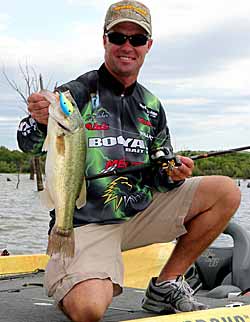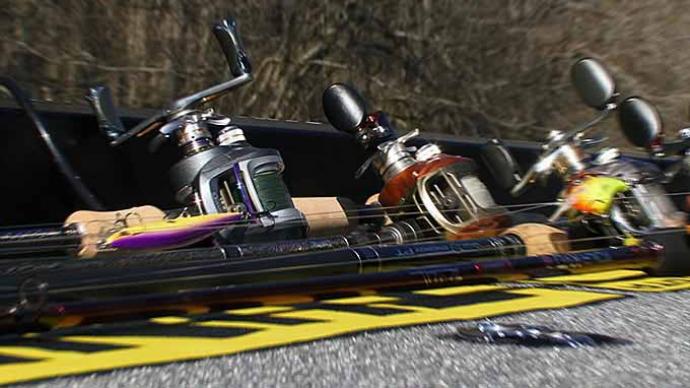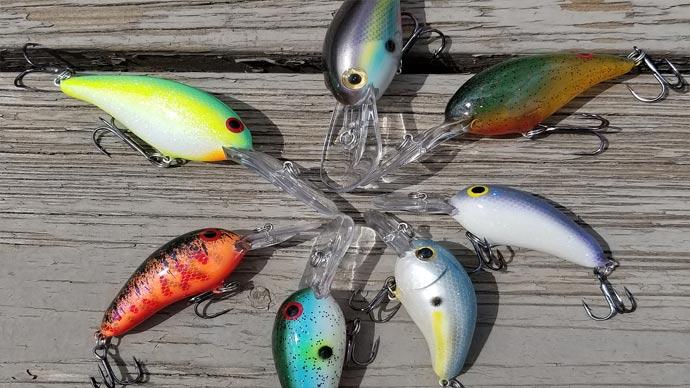
Most bass fishermen know that crankbaits rank among the most productive and user-friendly lures. Though various cranks look mighty similar in tackle trays, picking the best lure can get confusing. Retrieve is another variable that defines whether you get the job done. B.A.S.S. pro Terry Butcher has depended on crankbaits for many of his wins and has an advanced approach to selecting and fishing crankbaits.
A two-time B.A.S.S. winner who calls Oklahoma home, Butcher spends a lot of time with a crankbait tied to his line. He cranks through the seasons and in an enormous range of situations.
“I try to learn something about a lake and its tendencies for the time of year when I’ll be fishing,” Butcher said. “Generalities about the lake and the time of year, when combined with specific observations about conditions, tell me a lot about the kinds of areas I will fish and, consequently, the best crankbait to choose.”
Favorite Cranks
The most significant factor that plays into Butcher’s crankbait-selection decision is the depth of the water or the cover the fish are using. Generally speaking, he has favorite crankbaits for various depth ranges. That said, the ranges overlap, and at times he might choose a particular crankbait because of its wobble or a lure that runs too deep for the range because he wants to grind the bottom.
“Sometimes I might have three different crankbaits tied on and be switching from one to the next to fish the same bank,” Butcher said.
For super-shallow water, he likes the Booyah Square Lip XCS. It comes into play any time bass are in less than a couple of feet of water and using cover near the bank, but Butcher might choose it for water as deep as 4 feet if he expects the fish to be active. He uses a Square Lip the most from late spring through early fall when the water is warmer and active fish like a hard-kicking lure.
To get deeper, down to about 6 feet, Butcher will opt for the legendary Bomber 4A. He’ll sometimes use a 4A for fishing only a few feet of water when he expects fish to be shallow but wants a little tighter wiggle. He says that bass like that action early and late in the year. During the middle of the winter, if the water is frigid, Butcher might choose a Bomber Flat A, which has a super-tight wiggle and a narrow profile to imitate winter-slowed shad in shallow water.

For water that’s more than 6 feet, Butcher’s bait of choice is Bomber Gen 2 Fat Free Shad Jr. Crankbait, which is one size smaller than the original Fat Free Shad and doesn’t dig quite as deep. That bait covers his needs down to around 12 feet and usually is his first choice for medium depths. A Bomber Model 6A also comes into play for the same depth range, allowing him to offer a little different profile and wobble. It’s just one of those things that he has to let the fish tell him what they want on that day, he says.
For deep cranking, which encompasses most offshore applications and can be a factor for Butcher any month of the year, his go-to crankbait is always a full-sized Bomber Fat Free Shad.
Presentations Are As Important As The Lure
Butcher loves throwing a crankbait in shallow water, and he starts fishing with an aggressive attitude. He fishes it fast and smashes it into as much wood, rock, or other cover as possible.
“That’s what’s going on in shallow water,” Butcher said. “The shad are racing around trying to escape the bass, so I want that bait up there hitting and deflecting off things. Same thing with the crawfish. If you see them up around the shallow rocks, they move around erratically.”
Butcher believes in allowing the fish to dictate how they want the bait for deeper presentations. In most cases, he’s hitting the bottom or some cover at least some of the time. However, sometimes he wants his bait to barely tick the structure, while other times he wants a crankbait grinding and kicking up sediment. Retrieve speed varies greatly, as does the frequency (or existence) of pauses or rod tip sweeps.
“Some days, you have to reel steadily. Other days, whenever you hit something, you have to pause and let the bait float up a bit,” Butcher said. “I’ll experiment and adjust based on what the fish show me.”
Butcher has enjoyed tremendous success with a standard rattling Fat Free Shad BD8, so that remains his primary bait for deep cranking. It’s his deep diver of choice when searching for fish and his normal first pick when he pulls up on a spot. Once he has worked a ledge or hump thoroughly, though, and has pulled what fish he thinks he can from it, he often picks up a rod rigged with a silent version of the same crankbait.
“Sometimes you’ll catch another fish or two from a spot just by making that change,” he says. “The one with the rattles is my first choice, but there seem to be some fish that prefer the silent one.”
Another adjustment Butcher commonly makes before abandoning a spot is to work the same structure from the opposite side.
“If I started out positioned just off a ledge and worked my crankbait down it, I’ll move to the shallow side and try working up it. It’s a presentation fish don’t see a lot.”
Still another way Butcher varies his crankbait approach is by keeping the same model and color of crankbait tied to more than one rod, but each is spooled with a different line weight. Any given crankbait fished on lighter line runs deeper, so trying a couple of combinations over a structure or along a stretch of the bank helps him zero in on just the right amount of bottom contact for triggering strikes any given day.
Butcher’s Block of Cranking Colors
Bomber Fat Free Shad/Bomber Model A
Foxy Shad – Any Time
Chartreuse Blue Back – Any Time
Dance’s Citrus Shad – Extra Clear Water
Dance’s Tennessee Shad – Extra Clear Water
Foxy Lady – Dingy Water
Booyah Square Bill Xcs - https://bit.ly/3WSLJ9r
Foxy Shad – Any Time
Oxbow – Dirty Water
Mossback Craw – Bass On A Crawfish Bite
Creek Craw – Bass On A Crawfish Bite
BassResource may receive a portion of revenues if you make a purchase using a link above.




